Water
Water is probably the neatest thing in this universe. All life
on earth depends on it, and it has physical properties that makes life itself
possible.
Facts about water ... click
here.
-
Life got started in water (very simple algae, "cyanobacteria" appeared
about 3.5 billion years ago in what is now Australia)
-
Water provided the only protection to life by filtering out harmful UV
radiation.
-
Water covers 71% of the earth's surface. Water's high specific heat
(ability to absorb or emit large amounts of energy without producing a
major temperature change) provides the earth with a natural mechanism to
stabilize climate and extreme temperature swings. I'm sure you are
familiar with the phrase "cooler near the lake" during hot summer days.
-
Water expands 9% upon freezing. If this were not so (and it behaved
like most all substances), it would freeze in winter and SINK to the bottom
of a lake. Lakes would then easily freeze completely solid ... making
all marine life impossible. Instead, it stays on the surface acting
like an insulator ... protecting marine life from the extreme cold above.
-
Water is called a "polar molecule". This means that water has tiny
electric charges at its ends. This property allows water to dissolve
many things it comes in contact with (solubility) - a chemists dream!
-
Water has been detected on Mars (at least in its past), on comets, in
meteorites, and even deep
space. Maybe water is allowing other worlds to study water!
Water naturally exits on the earth in all three phases
- solid,
liquid, and vapor
When it rains ...
When it rains, water reaching the surface does one of 4 things.
- It evaporates back into the atmosphere.
- It flows over the surface to a different location (we saw what that can do
in unit 1).
- It is taken in by plants (and then released back to the atmosphere via
transpiration).
- It soaks into the ground to become groundwater.
The percentage depends on the amount of rain and nature of the surfaces.
For example, if you dump a bucket of water on your lawn in summer, almost all
the water will percolate into the soil. Do the same thing over your
driveway and it runs to a sewer.
Groundwater
Ground water is used for drinking water by about 50 percent of the nation's
population!
You already know that 97% of the earth's water is in the oceans but
undrinkable (unless you spend big bucks to desalinate the water).
It is also difficult to drink the 2% tied up in ice (even though it is
fresh in this form). That means that only 1% makes up the useful
water we all use. By far, the bulk of this remaining slice is groundwater.
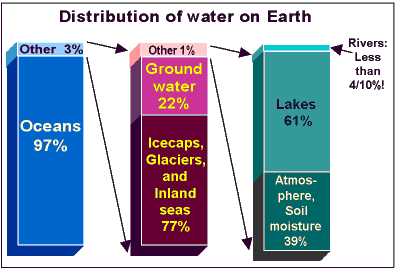
From the USGS
Where is this ground water? Just drill down until you "hit water"
in an area known as the water table.
As a kid, I thought this meant that there were great underground rivers
and lakes .... not true! (although these things do exist in some caves).
The water is simply trapped between pores, cracks and tiny spaces within
the existing rock. Have you ever played on the beach as a kid and
dug a great hole? You easily reach the water table and you can no
longer dig any deeper because the hole quickly fills with water.
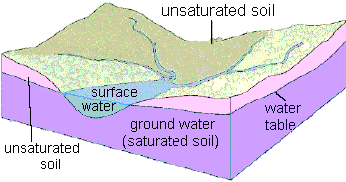
From the USGS
Click here for
more details.
Water (from rain) percolates into the soil and continues to filter until
it is "trapped" by an layer which will not allow water to penetrate ...
an impermeable layer. The layer of permeable rock containing the
water is known as the "zone of saturation". The water table marks
the top of this zone. Generally speaking, the shape of the water
table matches the contour of the surface. This is how groundwater is
recharged (adding to the supply of groundwater).
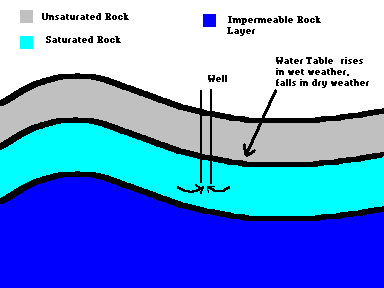
On occasion, the water table intersects the surface and you see a lake.
(I often wondered as a kid why water doesn't filter away.)
I get my water (in Wales) from a well. My well is 216 feet deep.
Some of my neighbors have wells over 500 feet deep ... a very expensive
location since drilling a well is definitely NOT cheap.
This saturated zone constitutes an aquifer if it can provide
an ample supply of usable water. An aquifer must be:
-
Porous - able to hold water (in open spaces)
-
Loose sediments make the best aquifers.
-
Permeable - able to transmit water (move easily)
-
Clay has low permeability (because it attracts water molecules) even though
it is porous.
-
If the rock has large fractures, water may move too quickly. The
slow motion of water through the ground acts like a filter, removing bacteria,
pesticides, dissolved salts, and pollutants. A country home may have
a septic system. Waste water should slowly filter down to the water
table so you don't end up sick (and also with an un-sellable house).
However, if the motion is too slow, your area may not "perk out" forcing
you to buy an expensive "mound" septic system. Check out which areas
of the state may experience groundwater
pollution.
-
Saturated - hold lots of water
-
Safe to drink - not polluted
South Eastern Wisconsin exists on an aquifer known as the
Cambrian Ordovician
aquifer.
(the net flow is toward Lake Michigan... especially toward
major cities where it is withdrawn in great quantities ... and rapidly dropping
>800 feet since the civil war because of it .)
If you want to research any aquifer in the US, click
here.
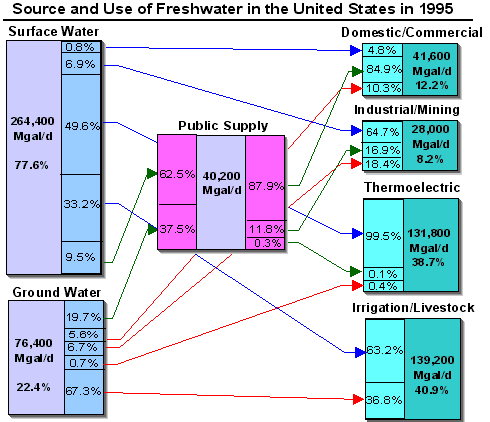
From the
USGS
This rather complicated graphic is trying to say that most of the nations water
(77.6%) comes from surface water (lakes & rivers) and only 22.4% comes from
groundwater. What is this water used for? Mostly on farms (40.9% for
irrigation/livestock) & making electricity (38.7%).
Surface Water
A watershed
is the collection area for rainwater runoff. That is, all the rain that falls in
your watershed will flow to the same place (if it doesn't evaporate first or
filter into the ground as groundwater). It will flow into rivers and
lakes. Most people get their water supply from surface water (77.6% vs.
22.4% from groundwater). Before water from lakes and streams may be used, it must be
purified at a local water treatment plant.
Wisconsin watersheds
I live in the Upper
Fox River Watershed
(click here for
more information on Wisconsin watersheds)
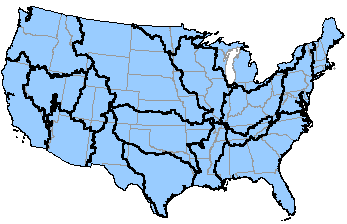
Permission from National
Watershed Network
There are 641 water treatment plants in Wisconsin (1990)
Wastewater Treated by Public Wastewater-Treatment Plants = 638 Mgal/d
Milwaukee is served
by United Water (working
with the Milwaukee Metropolitan Sewerage
District). United Water manages the Jones Island and South Shore
facilities handling 215 million gallons per day (MGD) and have capacities
of 330 MGD and 250 MGD, respectively.
Here are some of
the steps they use to purify our water:
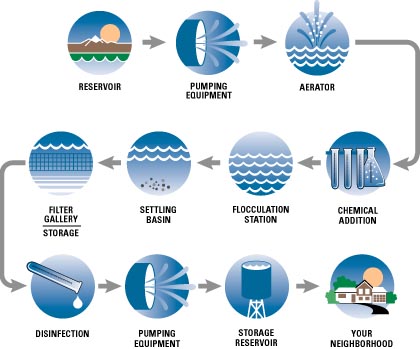
Permission from Unitedwater
- Obtain water from intakes deep in Lake Michigan
- Add chemicals to precipitate solids out
- Add chlorine to kill bacteria
- Filter out impurities
- Aerate to improve the taste
- Use Ozone to kill
cryptosporidium,
a parasite commonly found in surface waters such as lakes and rivers, especially
when the water is in contact with animal wastes and sewage. (remember 1993?
... did you get sick?)
Waukesha (city) gets its water from a municipal
well (ground water)
Problems related to water withdrawal:
-
Pollution from landfills and fertilizers / pesticides / wastes (farms)
-
Drops in water levels due to over usage (ground water)
-
Radium levels
(see a state map)
-
Places like Saudi Arabia (and other Mid Eastern countries) must desalinate
its water using an expensive reverse osmosis process (and other techniques)
... they have cheap oil but expensive water!
Water links:
http://ga.water.usgs.gov/edu/
http://www.epa.gov/surf/
ŠJim Mihal 2004, 2006 - all rights reserved





